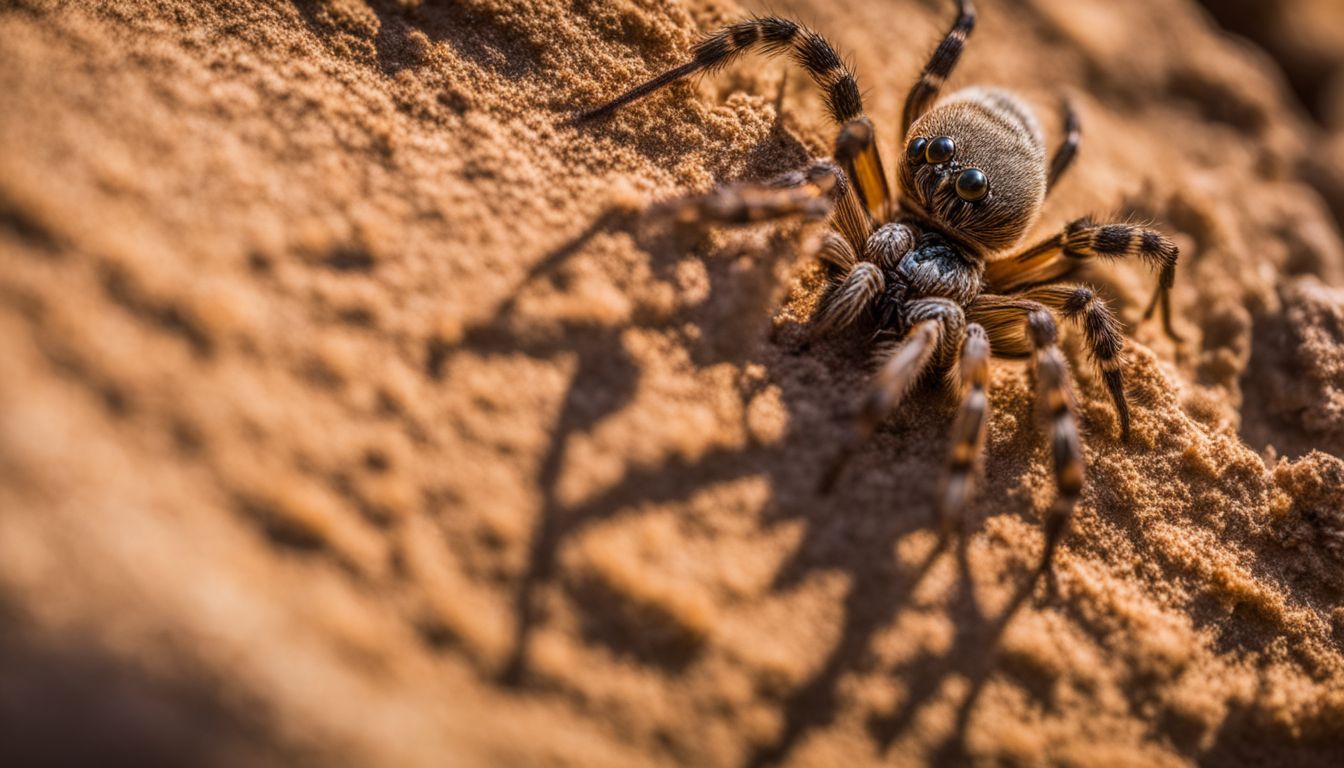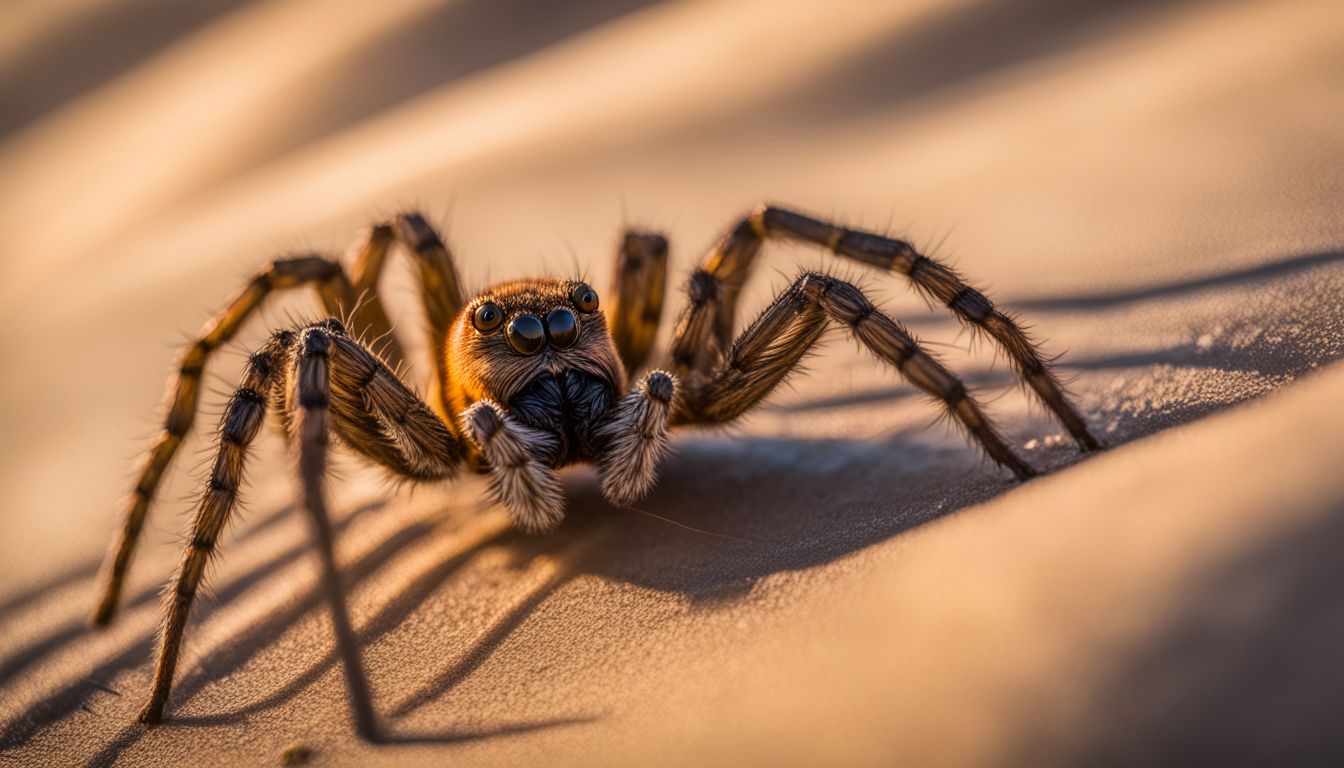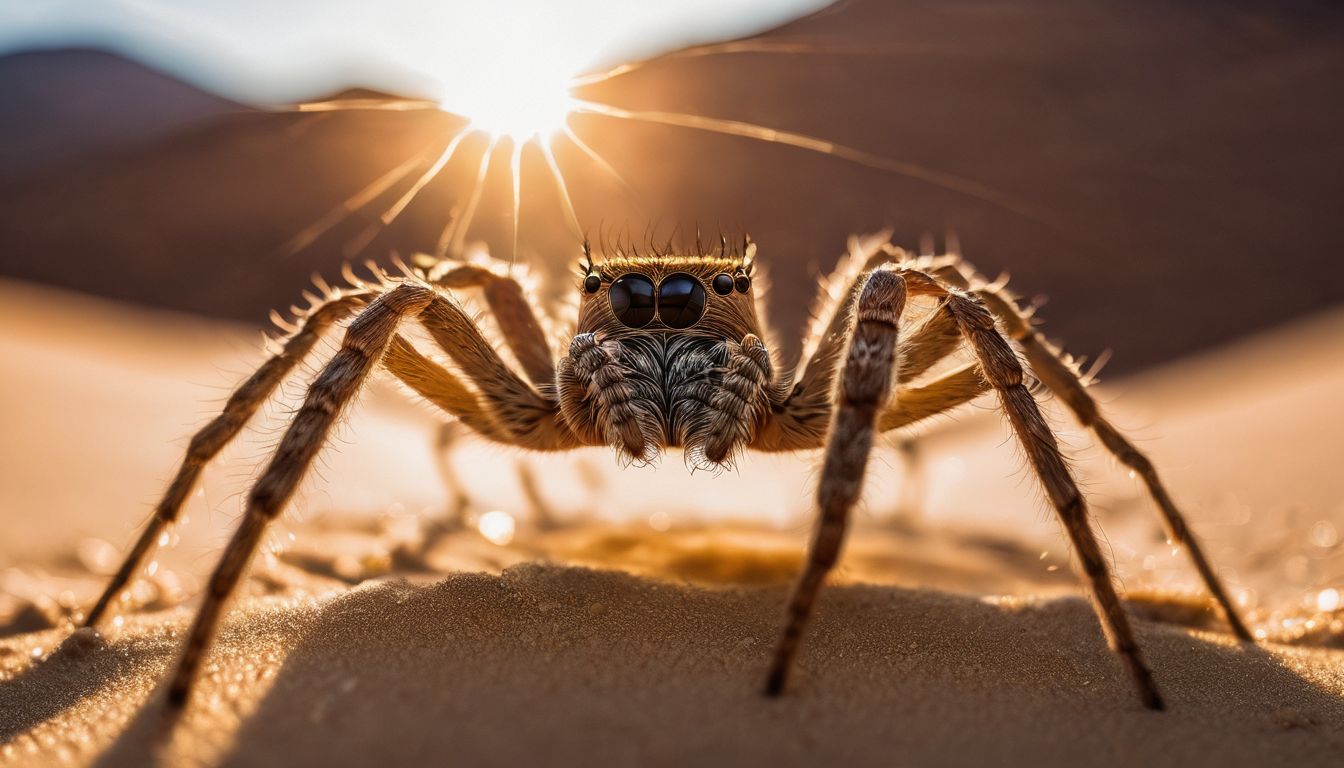Many people wonder if sun spiders are a danger to them or their pets. Despite their fierce appearance, sun spiders are not poisonous and can’t harm humans with venom. Our blog will clear up any confusion by diving into the fascinating world of these creatures and explaining what they’re really about.
Keep reading to uncover the truth behind the myths of sun spiders.
Key Takeaways
- Sun spiders are not poisonous or venomous and cannot harm humans with their bite.
- Their bites may cause mild pain and irritation, but they do not pose a significant health risk to humans.
- Understanding the truth about sun spiders helps prevent unnecessary fear and misconceptions about these non-venomous arachnids.
Demystifying the Sun Spider: What You Should Know

Sun spiders, also known as wind scorpions or camel spiders, are not actually venomous or poisonous. They are non-venomous arachnids and play a crucial role in controlling insect populations in their habitats.
Understanding their behavior and characteristics can help prevent unnecessary fear and misconceptions about these fascinating creatures.
Sun Spider Identification
To spot a sun spider, look for its unique shape. These creatures have eight legs and two extra appendages called pedipalps that look like little arms. Their bodies are split into two main parts, the front part is the head and chest combined – this is known as the cephalothorax.
The back part is their round belly, called the opisthosoma. Sun spiders can be quite hairy and usually show up in light brown or yellow colors.
Their front limbs grab prey just like scorpions do, but don’t worry—they’re not out to get us! Unlike venomous spiders with well-known bites, sun spiders don’t have poison to hurt people.
They might seem scary because they move quickly and chase shadows, but they are just looking for insects to eat, not humans to bite.
Habitat and Behavior
Now, let’s talk about where sun spiders live and how they act. Sun spiders are found in hot deserts and dry lands. They love the warm ground and often hide under rocks or inside burrows during the day.
At night, these speedy critters come out to hunt for food.
Sun spiders chase down their meals with amazing speed. They eat bugs like beetles and can even chomp on small lizards. Unlike true scorpions, sun spiders don’t have a sting in their tails but have strong mouthparts to grab prey.
They are not pests and usually stay away from people unless they accidentally wander into homes looking for something to munch on.
The Truth About Sun Spider Bites

Sun spiders are not venomous or poisonous, and their bites are generally harmless to humans. However, their bites can cause mild pain and irritation, so it’s important to know the symptoms and treatment options in case of a bite.
Are Sun Spiders Venomous or Poisonous?
Sun spiders may look scary, but they are not venomous or poisonous. They can bite if they feel trapped or threatened, and this bite might hurt a lot. However, their bites do not harm people like a venomous spider’s bite would.
The pain from a sun spider bite happens because of the pinch from their strong jaws rather than any kind of poison.
After learning about sun spider bites, it’s good to know what symptoms you might have if you get bitten and how to treat them.
Symptoms and Treatment of Sun Spider Bites
After understanding whether sun spiders are venomous or poisonous, it’s crucial to know the symptoms and treatment in case of a bite. Here is what you should know:
- Sun spider bites can cause itching, irritation, and pain at the bite site.
- Systemic symptoms may include headache and, in rare cases, anaphylaxis – a severe allergic reaction requiring immediate medical attention.
- If bitten, clean the wound with soap and water, apply an antibiotic ointment, and use pain relievers such as ibuprofen to alleviate discomfort.
- Seek medical attention if there’s persistent pain, redness, or swelling at the bite site or if systemic symptoms like headache occur.
When to Seek Medical Attention
If you experience any of these symptoms after a spider bite, seek immediate medical care:
- Severe pain at the bite site that doesn’t improve
- Increasing redness, swelling, or warmth around the bite
- Difficulty breathing or chest tightness
- Nausea, vomiting, or sweating
- Muscle spasms or weakness
- Rapid heartbeat or palpitations
Myths and Questions about Sun Spiders
Explore the common myths and misconceptions surrounding sun spiders, such as whether they can drown or if they are related to brown recluse spiders. Get clarity on these questions and more in this section.
Do Sun Spiders Drown?
Sun spiders are not aquatic creatures, so they don’t live in or near water. They can accidentally fall into water but can’t swim. If a sun spider stays submerged for too long, it can drown.
So it’s important to keep them away from areas with standing water to prevent accidental drowning and ensure their survival.
Sun spiders are desert-dwelling arachnids that prefer dry environments and are not equipped for surviving in water. Their inability to swim makes it essential to avoid situations where they might get trapped underwater, helping to protect these fascinating creatures from harm.
Preventing Unwanted Encounters with Sun Spiders
To avoid unwanted encounters with sun spiders, it’s important to keep your home clean and clutter-free, as they are attracted to dark and messy spaces. Sealing cracks and crevices in your home and using pest control methods can also help prevent infestations.
Effective Control and Prevention Methods
To control and prevent sun spiders effectively, here are some simple and practical methods:
- Maintain a clean home environment by regularly vacuuming and removing clutter to discourage sun spider nesting.
- Seal cracks, crevices, and small openings around doors, windows, and utility penetrations using caulk or other appropriate materials to prevent their entry.
- Use sticky traps strategically in areas where sun spiders are likely to travel, such as along walls and in corners.
- Implement pest – proofing measures by fixing torn window screens and repairing gaps in door sweeps to keep spiders out of the house.
- Consider professional pest management services if the infestation is severe or persistent.
Natural and Home Remedies
Natural and home remedies can be effective in keeping sun spiders away. Here are some simple methods you can use:
- Maintain a Clean Environment: Regularly clean and declutter your home, especially in hidden areas where sun spiders may hide.
- Use Mint Leaves: Plant mint leaves near entryways to deter sun spiders from entering the house due to its strong scent that they dislike.
- Diatomaceous Earth: Sprinkle diatomaceous earth around the perimeter of your home to create a barrier that will repel sun spiders and other pests.
Sun Spiders and Their Role in the Ecosystem
Sun spiders, also known as solifuges or wind scorpions, are beneficial predators in the ecosystem. Their diet primarily consists of insects and other small arthropods, helping to control their populations.
By preying on pests like crickets and cockroaches, sun spiders contribute to maintaining a balance in the food chain. Additionally, their role as predators helps keep the populations of harmful insects in check, which is essential for maintaining ecological harmony.
These arachnids actively contribute to the natural control of pest species such as termites and grasshoppers. As a result, they play an important role in maintaining healthy ecosystems by regulating the numbers of various insect populations that could otherwise become pests.
Conclusion: Understanding the Reality of Sun Spiders
In conclusion, sun spiders, also known as wind scorpions or camel spiders, are not poisonous to humans or pets. Despite their intimidating appearance and aggressive behavior, they do not possess venom and are relatively harmless.
It’s important for novices to understand the truth about sun spiders to prevent unnecessary fear and misunderstanding. Educating oneself about these fascinating creatures can help avoid misconceptions and unnecessary precautions regarding their presence.
Understanding the reality of sun spiders is essential in promoting coexistence with these intriguing arachnids.
If you’re curious about whether these fascinating creatures can survive underwater, learn more by reading our article on “Do Sun Spiders Drown?”
FAQs
1. What is a sun spider?
A sun spider, also known as solpugid, is a creature with a body made of two parts: the front part called the carapace and the back part with abdominal segments. It has many legs and moves fast.
2. Are sun spiders dangerous to people?
No, sun spiders are not poisonous and cannot make you sick with venom like some other spiders can.
3. Can you get hurt by a sun spider bite?
Sun spiders might scare you with their big jaws but if they bite it usually just hurts a bit. If someone has allergies or sensitive skin, the spot might become red or swell up.
4. What should I do if I am bitten by a sun spider?
If bitten by one of these creatures, clean the area well and use creams like triple antibiotic ointment to stop infection. Over-the-counter pain medicine may help too if it hurts.
5. Do I need to worry about bacterial infections from their bites?
It’s rare but possible for any bite to get infected which makes seeing doctors important if wounds look bad or don’t heal right.
6. Are there ways to keep away from being bitten by Sun Spiders
Keeping houses clean can help because these critters like places where bugs are found since they eat them; using commercial pesticides carefully according to instructions might also be useful.




